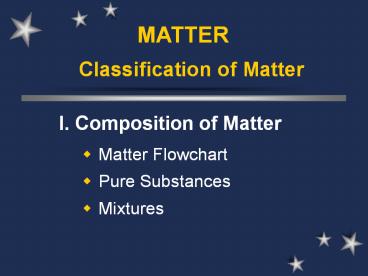Classification of Matter - PowerPoint PPT Presentation
Title:
Classification of Matter
Description:
MATTER Classification of Matter I. Composition of Matter Matter Flowchart Pure Substances Mixtures A. Matter Flowchart MATTER Can it be separated by physical means? – PowerPoint PPT presentation
Number of Views:115
Avg rating:3.0/5.0
Title: Classification of Matter
1
Classification of Matter
MATTER
- I. Composition of Matter
- Matter Flowchart
- Pure Substances
- Mixtures
2
A. Matter Flowchart
MATTER
yes
no
Can it be separated by physical means?
Homogeneous Mixture (solution)
Heterogeneous Mixture
Compound
Element
3
B. Pure Substances
- Element
- matter composed of identical atoms
- EX copper
4
Periodic Table of Elements
5
B. Pure Substances
- Compound/ Molecule
- matter composed of 2 or more elements in a fixed
ratio - properties differ from those of individual
elements - chemically combined
- EX salt (NaCl) or water (H2O)
6
Chemical Formulas
- Shows how many atoms of each element are in the
substance. - Example C16H10N2O2 is a blue dye.
- The number of atoms of each element is written
after the elements symbol as a subscript. - If only one atom is present, no subscript is
needed.
7
Chemical Formulas
- You try.
- C12H22O11
- How many atoms of each element are in this
formula? - C is for carbon.
- H is for hydrogen.
- O is for oxygen.
8
C. Mixtures
- Variable combination of 2 or more pure substances.
- Homogeneous Mixture (Solution)
- even distribution of components
- very small particles
- particles never settle
- EX saline solution
9
C. Mixtures
- Heterogeneous Mixture
- uneven distribution of components
- Can physically separate
- Colloids and Suspensions
- EX granite
10
C. Mixtures
- Colloid
- medium-sized particles
- Tyndall effect - particles scatter light (looks
cloudy) - particles never settle
- EX milk
11
C. Mixtures
- Suspension
- large particles
- particles scatter light
- particles will settle (needs to be shaken)
- EX fresh-squeezed lemonade
12
Law of Conservation of Mass and Energy
- Mass cannot be created nor destroyed
- Energy cannot be created nor destroyed it can be
transformed or transferred to other forms of
energy.
13
Solids, Liquids, Gases
- MATTER
- I. States of Matter
- Kinetic Molecular Theory
- Four States of Matter
- Thermal Expansion
14
A. Kinetic Molecular Theory
- KMT
- Tiny, constantly moving particles make up all
matter. - The kinetic energy (motion) of these particles
increases as temperature increases.
15
B. Four States of Matter
- Solids
- low KE - particles vibrate but cant move around
- definite shape volume
- crystalline - repeating geometric pattern
- amorphous - no pattern (e.g. glass, wax)
16
B. Four States of Matter
- Liquids
- higher KE - particles can move around but are
still close together - indefinite shape
- definite volume
17
B. Four States of Matter
- Gases
- high KE - particles can separate and move
throughout container - indefinite shape volume
18
B. Four States of Matter
- Plasma
- very high KE - particles collide with enough
energy to break into charged particles (/-) - gas-like, indefiniteshape volume
- stars, fluorescentlight bulbs, TV tubes
19
C. Thermal Expansion
- Most matter expands when heated contracts when
cooled. - ? Temp causes ? KE. Particles collide with more
force spread out. - EX thermostats (bimetallic strip)
20
Solids, Liquids, Gases
- MATTER
- II. Changes in State
- Phase Changes
- Heating Curves
21
A. Phase Changes
- Melting
- solid to liquid
- Freezing
- liquid to solid
- melting point freezing point
22
A. Phase Changes
- Vaporization (boiling)
- liquid to gas at the boiling point
- Evaporation
- liquid to gas below the boiling point
- Condensation
- gas to liquid
23
A. Phase Changes
- Sublimation
- solid to gas
- EX dry ice, freeze drying, iodine
24
A. Phase Changes
25
B. Heating Curves
- Kinetic Energy
- motion of particles
- related to temperature
- Potential Energy
- space between particles
- related to phase changes
26
B. Heating Curves
27
B. Heating Curves
- Heat of Fusion
- energy required to change from solid to liquid
- some attractive forces are broken
28
B. Heating Curves
- Heat of Vaporization
- energy required to change from liquid to gas
- all attractive forces are broken
- EX steam burns, sweating, and the drinking bird
- HEATING CURVE
29
Classification of Matter
MATTER
- II. Describing Matter
- Physical Property
- Physical Change
- Chemical Change
- Chemical Property
30
A. Physical Property
- A characteristic of a substance that can be
observed without changing its identity. - can be used to separate mixtures
- EX magnetism, density
31
B. Physical Change
- A change in the form of a substance without
changing its identity. - properties remain the same
- reversible
- can be used to separate mixtures
- EX dissolving, grinding
32
C. Chemical Change
- A change in the identity of a substance.
- properties change
- irreversible
- Signs color change, formation of a gas/solid,
release of light/heat - EX burning, rusting
33
D. Chemical Property
- A characteristic that indicates whether a
substance can undergo a specific chemical change. - EX flammability, reactivity































